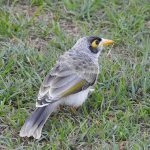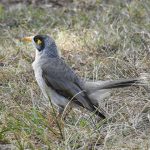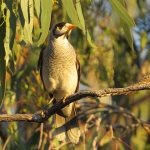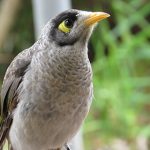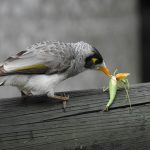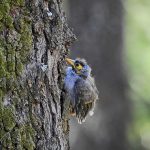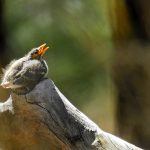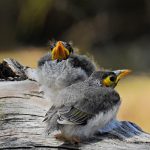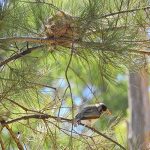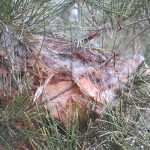NOISY MINER
Sharon:Close Encounter’ that I filmed when we were camping in outback New South Whales. Close to our campsite I noticed much commotion from 2 parent Noisy Miners. Of course, I had to take a look to see what was upsetting the. To my delight I noticed 3 tiny chicks which had just fledged from their nest. Trying to keep an eye on such tiny chicks was indeed keeping the parent birds busy. Watch and see what unfolded as I watched on from a distance, so as to not to disturb this Aussie Family
Noisy Miners: The Social Virtuosos of Australia
In the dappled light of Eastern Australia, where Eucalyptus canopies sway and city gardens bloom, a dynamic presence pulses through the landscape. The Noisy Miner is a bird whose voice is as unmistakable as its character—both a virtuoso and a guardian, shaping the very fabric of its environment. Let us explore their world, weaving together the remarkable facts and stories that make Noisy Miners truly extraordinary.
A Day in the Life: Song and Social Bonds
As dawn brushes the treetops with gold, a vibrant chorus rises—teu-teu-teu—echoing through forest edges and suburban streets alike. This is the daily serenade of the Noisy Miner, a communal song that not only claims territory but also unites the group. Picture yourself beneath a Eucalyptus tree: the morning air tinged with the sharp scent of oil, sunlight filtering through grey-green leaves, and the lively chatter of birds above.
Noisy Miners are not solitary performers. They flourish in cooperative groups, their lives interwoven in a tapestry of social ties and shared responsibilities. Family units of 6 to 30 birds form the core, but these may link into sprawling colonies of hundreds. In this world, every bird has a role to play.
The Cooperative Family
One of the most fascinating aspects of Noisy Miners is their approach to raising young. During the breeding season, from June to December, the female builds her nest high in the trees—a sturdy cup lined with the softness of moth cocoons and animal hair, held together by delicate cobwebs.
But the story of the nest is not one of solo effort. In a remarkable display of teamwork, “helpers at the nest”—often older siblings or other relatives—join the parents. Up to 10 birds may feed the chicks, delivering food as often as 50 times an hour. This cooperative breeding ensures that each chick has the best chance to thrive, a testament to the strength of their social bonds.
As you listen to the flutter of wings, breathe in the earthy aroma of damp bark, and watch a procession of birds tending the nest, it becomes clear: community is at the heart of the Noisy Miner’s success.
Guardians of the Canopy
Noisy Miners are fiercely protective of their home. If a threat—such as a snake, goanna, or even a much larger bird—approaches, the colony mobilises. They swarm the intruder with a cacophony of alarm calls and persistent dives, often driving it away. Their aggressive defence not only protects their own young but can also create safe zones for other species—though sometimes, their dominance can push quieter native birds out, reducing local diversity.
Urban Adaptation & Eucalyptus Love
Few native birds have adapted to urban living as successfully as the Noisy Miner. Wherever humans plant Eucalyptus or other flowering natives, these birds follow, feasting on nectar, fruit, and insects. Their presence turns city parks and backyards into lively theatres of sound and movement.
The Eucalyptus is especially beloved. Its blossoms provide a bounty of nectar, and the rough bark harbours countless insects. Stand beneath a flowering gum, and you may see Miners darting among the blooms, their yellow flashes bright against the blue sky.
Not a ‘Myna’ at All
Despite their name, Noisy Miners bear no relation to the introduced Common Myna, an Asian starling. Instead, they belong to the honeyeater family—true Australians, evolved to thrive in this unique environment.
Intelligence and Communication
The social world of Noisy Miners is rich and complex. Their vocalisations are not just noise, but a sophisticated system of chatters, whistles, and alarms, each with its own meaning. These birds use their voices to coordinate, to warn, and to bond, displaying a level of intelligence that matches their lively society.
A Double-Edged Success
The adaptability and teamwork of the Noisy Miner have made them a dominant force in both bushland and suburbia. But this very success serves as a gentle reminder: when one voice becomes too loud, others may struggle to be heard. Their story is a call for balance—by planting a variety of native shrubs and trees, we can help create habitats that welcome many species and preserve the rich chorus of Australian wildlife.
| Fascinating Fact | Detail |
|---|---|
| Cooperative Breeding | Helpers feed and protect chicks alongside parents |
| Aggressive Defence | Mob predators, protecting group and sometimes other species |
| Urban Adaptation | Thrive in cities, especially where native plants are abundant |
| Eucalyptus Preference | Rely on blossoms and insects found in Eucalyptus trees |
| Not a ‘Myna’ | Native honeyeater, unrelated to introduced Common Myna |
| Complex Communication | Use a wide range of calls for social coordination |
| Long Lifespan | Can live up to 10 years in the wild |
Conclusion: A Living Symphony
The Noisy Miner is more than just a bird; it is a living symbol of Australia’s vibrant, ever-changing landscapes. Their voices ring out every morning, a reminder of the power of community, the richness of adaptation, and the importance of balance in nature. As we listen to their chorus, let it inspire us to value every note in the wild symphony—and to protect the habitats that allow them, and all creatures, to thrive.
Our native Noisy miner should not be confused with the Indian Mynah, an unwelcome guest in Australia

